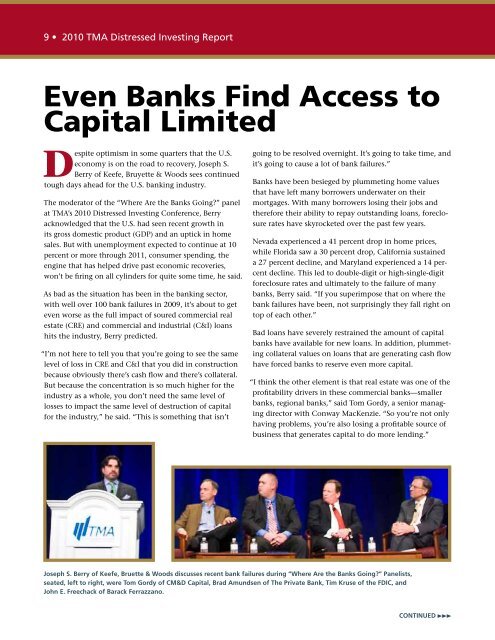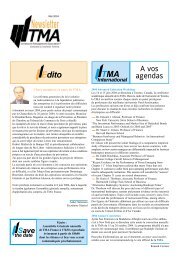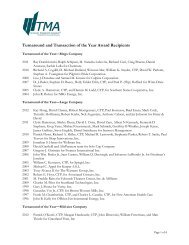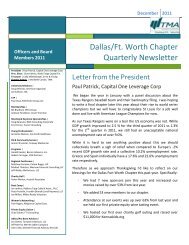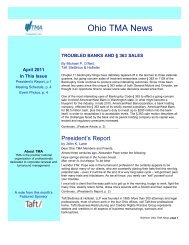Distressed Investing Report - Turnaround Management Association
Distressed Investing Report - Turnaround Management Association
Distressed Investing Report - Turnaround Management Association
You also want an ePaper? Increase the reach of your titles
YUMPU automatically turns print PDFs into web optimized ePapers that Google loves.
9 • 2010 TMA <strong>Distressed</strong> <strong>Investing</strong> <strong>Report</strong><br />
Even Banks Find Access to<br />
Capital Limited<br />
Despite optimism in some quarters that the U.S.<br />
economy is on the road to recovery, Joseph S.<br />
Berry of Keefe, Bruyette & Woods sees continued<br />
tough days ahead for the U.S. banking industry.<br />
The moderator of the “Where Are the Banks Going?” panel<br />
at TMA’s 2010 <strong>Distressed</strong> <strong>Investing</strong> Conference, Berry<br />
acknowledged that the U.S. had seen recent growth in<br />
its gross domestic product (GDP) and an uptick in home<br />
sales. But with unemployment expected to continue at 10<br />
percent or more through 2011, consumer spending, the<br />
engine that has helped drive past economic recoveries,<br />
won’t be firing on all cylinders for quite some time, he said.<br />
As bad as the situation has been in the banking sector,<br />
with well over 100 bank failures in 2009, it’s about to get<br />
even worse as the full impact of soured commercial real<br />
estate (CRE) and commercial and industrial (C&I) loans<br />
hits the industry, Berry predicted.<br />
“I’m not here to tell you that you’re going to see the same<br />
level of loss in CRE and C&I that you did in construction<br />
because obviously there’s cash flow and there’s collateral.<br />
But because the concentration is so much higher for the<br />
industry as a whole, you don’t need the same level of<br />
losses to impact the same level of destruction of capital<br />
for the industry,” he said. “This is something that isn’t<br />
going to be resolved overnight. It’s going to take time, and<br />
it’s going to cause a lot of bank failures.”<br />
Banks have been besieged by plummeting home values<br />
that have left many borrowers underwater on their<br />
mortgages. With many borrowers losing their jobs and<br />
therefore their ability to repay outstanding loans, foreclosure<br />
rates have skyrocketed over the past few years.<br />
Nevada experienced a 41 percent drop in home prices,<br />
while Florida saw a 30 percent drop, California sustained<br />
a 27 percent decline, and Maryland experienced a 14 percent<br />
decline. This led to double-digit or high-single-digit<br />
foreclosure rates and ultimately to the failure of many<br />
banks, Berry said. “If you superimpose that on where the<br />
bank failures have been, not surprisingly they fall right on<br />
top of each other.”<br />
Bad loans have severely restrained the amount of capital<br />
banks have available for new loans. In addition, plummeting<br />
collateral values on loans that are generating cash flow<br />
have forced banks to reserve even more capital.<br />
“I think the other element is that real estate was one of the<br />
profitability drivers in these commercial banks—smaller<br />
banks, regional banks,” said Tom Gordy, a senior managing<br />
director with Conway MacKenzie. “So you’re not only<br />
having problems, you’re also losing a profitable source of<br />
business that generates capital to do more lending.”<br />
Joseph S. Berry of Keefe, Bruette & Woods discusses recent bank failures during “Where Are the Banks Going?” Panelists,<br />
seated, left to right, were Tom Gordy of CM&D Capital, Brad Amundsen of The Private Bank, Tim Kruse of the FDIC, and<br />
John E. Freechack of Barack Ferrazzano.<br />
CONTINUED bbb


